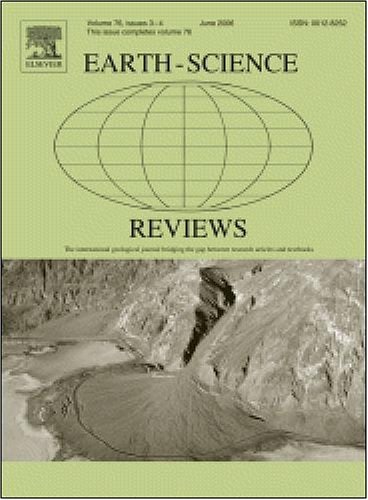A Middle Devonian fluvial-delta plain complex from eastern Yunnan, South China: Insights into co-evolution between environments and organisms in an early non-marine system
IF 10
1区 地球科学
Q1 GEOSCIENCES, MULTIDISCIPLINARY
引用次数: 0
Abstract
Fluvial-delta plain complex links land, fresh water, and marine habitats and acts as a springboard during terrestrialization of both plants and animals. Its geological records or related paleoecology study, during mid to late Paleozoic, however, are scarce. In this study, we reconstruct the paleoenvironmental and paleoecological framework of a Middle Devonian (c. 387 Ma) fluvial-delta plain complex from Wuding, eastern Yunnan, South China for the first time, using a combined approach of sedimentology, geochemistry, and palaeontology. Eight lithofacies of fluvial-delta plain are recognized from the Haikou Formation. The lower part of the Haikou Formation deposited in a meandering fluvial environment. While the middle-upper part of the Haikou Formation is interpreted as a brackish-fresh water setting (i.e., delta plain-swamp) based on facies analysis, stable isotope composition (δ18O, δ13C) of biogenic (ostracods) and authigenic carbonates, as well as paleosalinity proxies (Sr/Ba). A synthetic biota with a variety of fossil organisms, including ostracods (29 species belonging to 7 superfamilies), charophytes (1 species), chondrichthyans and antiarch fishes (at least 2 taxa), gastropods (1 taxa), bivalves, and spores (20 species belonging to 19 genera) have been recognized and identified in the delta plain-swamp facies. Ostracods are categorized into three distinct assemblages. Assemblage 1 (Leperditicope-Palaeocope assemblage) and Assemblage 3 (Paraparchitoidean assemblage) displaying high diversity and abundance, and characterize a brackish lower delta plain and a delta plain-swamp environment, respectively. Whilst the Assemblage 2 (Leperditioidean assemblage) has relatively low diversity and inhabited in fresh water, probably an upper delta plain setting. Leperdiditioideans are pioneers colonized fluvial-delta plain setting and might be the earliest fresh water ostracods. Additionally, a special fresh water species of Cypridoidea, Carbonita sp., which has never been reported prior to the Carboniferous Period, is discovered in the Haikou Formation. Abundant rhizomes of vascular land plants, as well as vertically arranged traces fossils (i.e., Scoyenia beerboweri) are observed from the flood plain facies, representing development of belowground soil ecosystem. The biota, especially those of the ostracods and charophytes, comprise a complex ecosystem spanning the marginal marine to terrestrial settings allowing a well-structured reconstruction of the eco-pyramid of brackish-fresh water ecosystem during the Middle Devonian. The results shed light on the co-evolution of the environment and organisms in the Devonian non-marine system.
滇东中泥盆世河流三角洲平原复合体:早期非海相系统中环境与生物的共同演化
河流三角洲平原连接着陆地、淡水和海洋栖息地,是动植物陆地化的跳板。但对其中晚古生代的地质记录和古生态学研究较少。本文采用沉积学、地球化学和古生物学相结合的方法,首次重建了云南东部武定地区中泥盆世(约387 Ma)河流三角洲平原杂岩的古环境和古生态格局。从海口组开始,可识别出河流三角洲平原的8个岩相。海口组下部沉积于曲流环境。根据相分析、生物(介形虫)和自生碳酸盐的稳定同位素组成(δ18O、δ13C)以及古盐度指标(Sr/Ba),海口组中上段为半咸淡水环境(即三角洲平原-沼泽)。在三角洲平原-沼泽相已发现了多种合成生物群,包括介形虫(7个超科29种)、绿肢动物(1种)、软骨鱼和反弓鱼(至少2个分类群)、腹足类(1个分类群)、双壳类和孢子(19属20种)。介形类分为 三个不同的组合。组合1 (leperditicope - paleocae组合)和组合3 (parapaparchitoidean组合)具有较高的多样性和丰度,分别表现为半咸淡下三角洲平原和三角洲平原-沼泽环境。而组合2 (Leperditioidean)多样性相对较低,生活在淡水中,可能是上游三角洲平原环境。Leperdiditioideans是河流三角洲平原地区的拓荒者,可能是最早的淡水介形类。此外,在海口组中还发现了石炭世以前从未报道过的一种塞浦路斯科(Carbonita sp.)。在洪泛平原相中发现了丰富的维管陆生植物根茎,以及垂直排列的痕迹化石(如Scoyenia beerboweri),代表了地下土壤生态系统的发育。该生物群,特别是介形类和绿叶类生物群,构成了一个复杂的生态系统,涵盖了海洋到陆地的边缘环境,可以很好地重建中泥盆世咸水生态系统的生态金字塔。研究结果揭示了泥盆纪非海洋系统中环境与生物的共同进化。
本文章由计算机程序翻译,如有差异,请以英文原文为准。
求助全文
约1分钟内获得全文
求助全文
来源期刊

Earth-Science Reviews
地学-地球科学综合
CiteScore
21.70
自引率
5.80%
发文量
294
审稿时长
15.1 weeks
期刊介绍:
Covering a much wider field than the usual specialist journals, Earth Science Reviews publishes review articles dealing with all aspects of Earth Sciences, and is an important vehicle for allowing readers to see their particular interest related to the Earth Sciences as a whole.
 求助内容:
求助内容: 应助结果提醒方式:
应助结果提醒方式:


